
Phonograph cylinders are the earliest commercial medium for recording and reproducing sound. Commonly known simply as "records" in their era of greatest popularity, these hollow cylindrical objects have an audio recording engraved on the outside surface, which can be reproduced when they are played on a mechanical cylinder phonograph. In the 1910s, the competing disc record system triumphed in the marketplace to become the dominant commercial audio medium.

Leeds Talk-O-Phone was a record label, producing cylinders from 1894 to 1903 and single-sided lateral-cut disc phonograph records in the United States of America from about 1902 to 1909.

Columbia Graphophone Co. Ltd. was one of the earliest gramophone companies in the United Kingdom.
The Gramophone Company Limited , based in the United Kingdom and founded on behalf of Emil Berliner, was one of the early recording companies, the parent organisation for the His Master's Voice (HMV) label, and the European affiliate of the American Victor Talking Machine Company. Although the company merged with the Columbia Graphophone Company in 1931 to form Electric and Musical Industries Limited (EMI), its name "The Gramophone Company Limited" continued in the UK into the 1970s.

Edison Records was one of the early record labels that pioneered sound recording and reproduction, and was an important player in the early recording industry.

Vim Records was a short-lived American record label that was active during the early 1900s. Vim discs include issues of ragtime banjo music recorded by Vess L. Ossman.
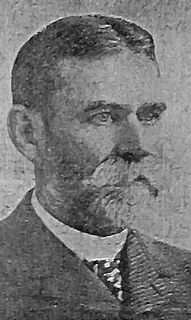
Charles Sumner Tainter was an American scientific instrument maker, engineer and inventor, best known for his collaborations with Alexander Graham Bell, Chichester Bell, Alexander's father-in-law Gardiner Hubbard, and for his significant improvements to Thomas Edison's phonograph, resulting in the Graphophone, one version of which was the first Dictaphone.

The Graphophone was the name and trademark of an improved version of the phonograph. It was invented at the Volta Laboratory established by Alexander Graham Bell in Washington, D.C., United States.
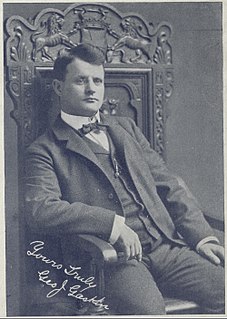
George J. Gaskin was one of the most popular singers in the United States during the 1890s and an early American recording artist.
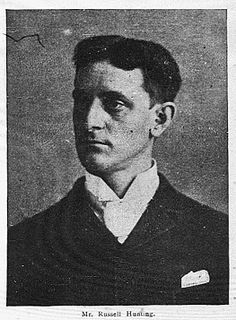
Russell Dinsmore Hunting was an American comic entertainer, pioneer sound recordist, and an influential figure in the early years of the recorded music industry. He was described as "the most popular pre-1900 recording artist".

Daniel William Quinn was one of the first American singers to become popular in the new medium of recorded music. Quinn was a very successful recording artist whose career spanned from 1892 to 1918. Quinn recorded many of his hits in the legendary Tin Pan Alley of New York City.

The Volta Laboratory and the Volta Bureau were created in Georgetown, Washington, D.C. by Alexander Graham Bell.(19/20th-century scientist and inventor best known for his work on the telephone)

John W. Myers, who was usually credited as J. W. Myers, was a Welsh-born baritone singer, who recorded widely in the United States between the early 1890s and early 1917. His recordings, including "Two Little Girls in Blue" (1893), "The Sidewalks of New York" (1895), "Just Tell Them That You Saw Me" (1895), "When You Were Sweet Sixteen" (1901), "On a Sunday Afternoon" (1902), "Way Down In Old Indiana" (1902), and "In the Good Old Summer Time" (1902), were among the most popular of the period.
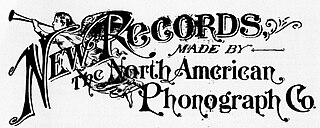
The North American Phonograph Company was an early attempt to commercialize the maturing technologies of sound recording in the late 1880s and early 1890s. Though the company was largely unsuccessful in its goals due to legal, technical and financial problems, it set the stage for the modern recording industry in the mid 1890s.
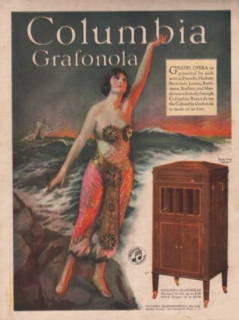
The Columbia Grafonola is a brand of early 20th century American phonograph made by the Columbia Graphophone Company. Introduced in 1907, Grafonolas are internal horn alternatives to the same company's external horn Disc Graphophones.

Edward Denison Easton was the founder and president of the Columbia Phonograph Company. Under Easton's leadership, Columbia developed from one of many regional subsidiaries of the North American Phonograph Company to one of the United States' three major record companies in the early part of the 20th century.

The United States Phonograph Company was a manufacturer of cylinder phonograph records and supplies in the 1890s. It was formed in the Spring of 1893 by Victor Emerson, manager of the New Jersey Phonograph Company. Simon S. Ott and George E. Tewkesbury, heads of the Kansas Phonograph Company and inventors of an automatic phonograph joined later. It was based in Newark, New Jersey. After the collapse of the North American Phonograph Company in August 1894, the United States Phonograph Company became one of the industry's largest suppliers of records, competing mostly with the Columbia Phonograph Company who had joined with the American Graphophone Company to manufacture graphophones, blank wax cylinders, and original and duplicate records. The USPC manufactured duplicates as well, which allowed their recording program to reach the scale of competing with Columbia's. Their central location and proximity to New York allowed them to record the most popular artists of the 1890s, including George J. Gaskin, Dan W. Quinn, Len Spencer, Russell Hunting and Issler's Orchestra. Emerson left the company to lead Columbia's recording department around the summer of 1896. In 1897 the USPC worked with Edison's National Phonograph Company to retrofit phonographs with spring motors invented by Frank Capps. The convenience and cost savings of spring-motor phonographs like these helped shift the phonograph from a public entertainment to a consumer good. In October 1899 the company was prohibited by court order from manufacturing duplicate records, and they began supplying original records for the National Phonograph Company[7][7][6][6][5][5]. The later U.S. Phonograph Company of Cleveland Ohio is unrelated.
Edison Bell was an English company that was the first distributor and an early manufacturer of gramophones and gramophone records. The company survived through several incarnations, becoming a top producer of budget records in England through the early 1930s until, after it was absorbed by Decca in 1932, production of various Edison Bell labels ceased.
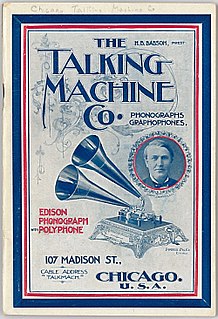
The Chicago Talking Machine Company was a manufacturer and dealer of phonographs, phonograph accessories, and phonograph records from 1893 until 1906, and a major wholesaler of Victor Talking Machine Company products between 1906 and at least 1928.

Frank P. Banta was an American pianist and recording artist active in the 1890s and 1900s.


















